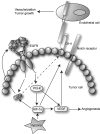The functional role of Notch signaling in human gliomas
- PMID: 20150387
- PMCID: PMC2940575
- DOI: 10.1093/neuonc/nop022
The functional role of Notch signaling in human gliomas
Abstract
Gliomas are among the most devastating adult tumors for which there is currently no cure. The tumors are derived from brain glial tissue and comprise several diverse tumor forms and grades. Recent reports highlight the importance of cancer-initiating cells in the malignancy of gliomas. These cells have been referred to as brain cancer stem cells (bCSC), as they share similarities to normal neural stem cells in the brain. The Notch signaling pathway is involved in cell fate decisions throughout normal development and in stem cell proliferation and maintenance. The role of Notch in cancer is now firmly established, and recent data implicate a role for Notch signaling also in gliomas and bCSC. In this review, we explore the role of the Notch signaling pathway in gliomas with emphasis on its role in normal brain development and its interplay with pathways and processes that are characteristic of malignant gliomas.
Figures





Comment in
-
Tumor stem cells, notch, and the news.Neuro Oncol. 2010 Feb;12(2):115. doi: 10.1093/neuonc/nop055. Neuro Oncol. 2010. PMID: 20150377 Free PMC article. No abstract available.
Similar articles
-
Take It Down a NOTCH in Forebrain Tumors.Cancer Cell. 2015 Dec 14;28(6):681-682. doi: 10.1016/j.ccell.2015.11.008. Cancer Cell. 2015. PMID: 26678333
-
A Tumor Suppressor Function for Notch Signaling in Forebrain Tumor Subtypes.Cancer Cell. 2015 Dec 14;28(6):730-742. doi: 10.1016/j.ccell.2015.10.008. Epub 2015 Dec 5. Cancer Cell. 2015. PMID: 26669487
-
Level of Notch activation determines the effect on growth and stem cell-like features in glioblastoma multiforme neurosphere cultures.Cancer Biol Ther. 2013 Jul;14(7):625-37. doi: 10.4161/cbt.24595. Epub 2013 May 10. Cancer Biol Ther. 2013. PMID: 23792644 Free PMC article.
-
Notch, neural stem cells, and brain tumors.Cold Spring Harb Symp Quant Biol. 2008;73:367-75. doi: 10.1101/sqb.2008.73.013. Epub 2008 Nov 6. Cold Spring Harb Symp Quant Biol. 2008. PMID: 19022772 Free PMC article. Review.
-
Brain tumor stem cells as therapeutic targets in models of glioma.Yonsei Med J. 2010 Sep;51(5):633-40. doi: 10.3349/ymj.2010.51.5.633. Yonsei Med J. 2010. PMID: 20635435 Free PMC article. Review.
Cited by
-
Prolonged inhibition of glioblastoma xenograft initiation and clonogenic growth following in vivo Notch blockade.Clin Cancer Res. 2013 Jun 15;19(12):3224-33. doi: 10.1158/1078-0432.CCR-12-2119. Epub 2013 Apr 29. Clin Cancer Res. 2013. PMID: 23630166 Free PMC article.
-
Molecular and Clinical Effects of Notch Inhibition in Glioma Patients: A Phase 0/I Trial.Clin Cancer Res. 2016 Oct 1;22(19):4786-4796. doi: 10.1158/1078-0432.CCR-16-0048. Epub 2016 May 6. Clin Cancer Res. 2016. PMID: 27154916 Free PMC article. Clinical Trial.
-
Implications of Dll4-Notch signaling activation in primary glioblastoma multiforme.Neuro Oncol. 2013 Oct;15(10):1366-78. doi: 10.1093/neuonc/not071. Epub 2013 Jun 20. Neuro Oncol. 2013. PMID: 23787764 Free PMC article.
-
Tracing the origins of glioblastoma by investigating the role of gliogenic and related neurogenic genes/signaling pathways in GBM development: a systematic review.World J Surg Oncol. 2022 May 10;20(1):146. doi: 10.1186/s12957-022-02602-5. World J Surg Oncol. 2022. PMID: 35538578 Free PMC article.
-
The Role of SVZ Stem Cells in Glioblastoma.Cancers (Basel). 2019 Mar 29;11(4):448. doi: 10.3390/cancers11040448. Cancers (Basel). 2019. PMID: 30934929 Free PMC article. Review.
References
-
- Stupp R, Mason WP, van den Bent MJ, et al. Radiotherapy plus concomitant and adjuvant temozolomide for glioblastoma. N Engl J Med. 2005;10:987–996. - PubMed
-
- Galli R, Binda E, Orfanelli U, et al. Isolation and characterization of tumorigenic, stem-like neural precursors from human glioblastoma. Cancer Res. 2004;19:7011–7021. - PubMed
-
- Singh SK, Clarke ID, Terasaki M, et al. Identification of a cancer stem cell in human brain tumors. Cancer Res. 2003;18:5821–5828. - PubMed
-
- Bao S, Wu Q, McLendon RE, et al. Glioma stem cells promote radioresistance by preferential activation of the DNA damage response. Nature. 2006;444:756–760. - PubMed
-
- Artavanis-Tsakonas S, Rand MD, Lake RJ. Notch signaling: cell fate control and signal integration in development. Science. 1999;5415:770–776. - PubMed
Publication types
MeSH terms
Substances
LinkOut - more resources
Full Text Sources
Other Literature Sources
Medical

